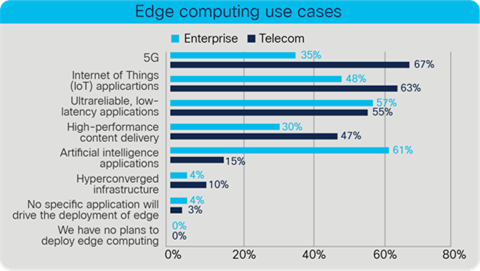Edge computing is a market on the move – with Forrester predicting the edge cloud service market will grow by at least 50% this year.
The 2020 Cisco Annual Internet Report showed the popularity of edge computing use cases within both enterprises and telecom. Telecom’s most likely use cases are enabled by 5G (67%) followed by IoT applications (63%). For enterprises, Artificial Intelligence (AI) applications are top (61%) and in second was ultra–reliable, low-latency applications (57%). 5G is arguably just as much of a super efficient delivery mechanism as it will enable applications for edge computing. With smart content delivery, Augmented Reality, Cloud gaming, video analytics, remote factory, eHealth and low latency applications all being a key part of 5G’s future.
Edge computing brings processing closer to the devices where it’s consumed. Data is processed by a local server or data centre instead of a central location that could be hundreds of miles away. By reducing the flow of traffic across the network and reducing latency, it reduces network congestion, improves application performance and the rapid delivery of content.
According to Gartner, around 10% of enterprise-generated data is created and processed outside a traditional centralised data centre or cloud and they predict that by 2025, the figure will reach 75%. Edge computing will play a key role by addressing some of challenges in cloud infrastructure by bringing data closer to the users. Stats from IDC research state, “In 3 years, 45% of IoT-created data will be stored, processed, analysed, and acted upon close to, or at the edge of, the network and over six billion devices will be connected to the edge computing solution.”
So many aspects of the network of tomorrow will be enabled or delivered by edge computing, from the IoT to new 5G applications, AI and ultra low latency applications or products. For enterprises, they’ll see improved application performance, quicker processing of data and increased efficiency. Telcos will have to better manage network capacity, more distributed hot spots (Vs the hyperscaler data centres) and deliver and improved user experience. All of this has to be underpinned by an agile network that can support high capacity and extreme low latency, with the ability to scale connectivity and bandwidth up and down into these new edge locations.
Even if edge computing isn’t on the immediate roadmap, planning your network now is key to delivering it in the future. At Colt we’ve already been building the network of tomorrow – delivery high-bandwidth, low latency connectivity and On Demand portal into the enterprise locations and data centres that are key to enabling this rapidly growing trend.
Aaron Partouche, 5G & Edge – New Business Development Director
What's your goal today?
1. Are you on the Colt IQ network?
Our network connects over 31,000 buildings worldwide powering companies such as Hitachi, Atos, Forbes, Arthur D Little, Brussels Airlines and thousands of others. Find out if you're Colt connected now.
2. Learn about digital infrastructure
We've written thousands of guides and white papers, regularly publish content on our blog and host regular events on everything from enterprise network connectivity, to cloud, digital transformation and the hybrid workforce.
3. Join our team
To learn more about joining our team of over 5000 people around the world, and to browse our current open roles visit https://careers.colt.net/.


